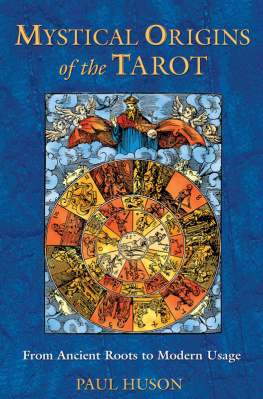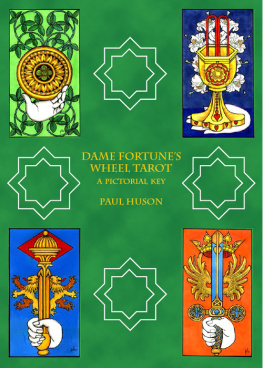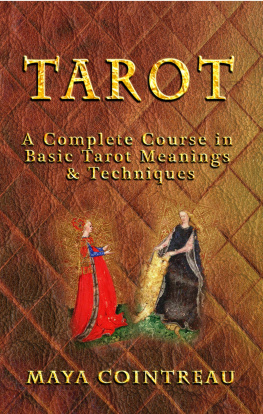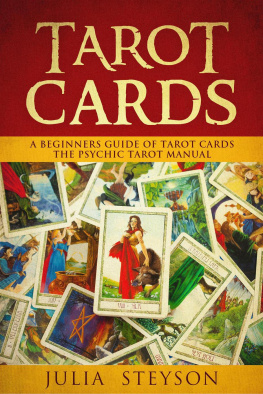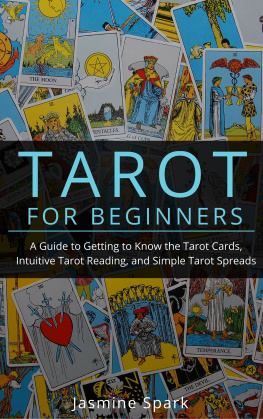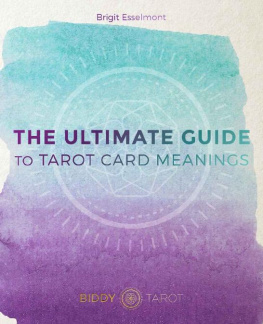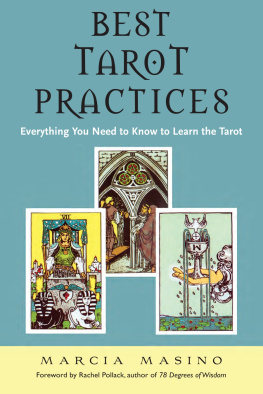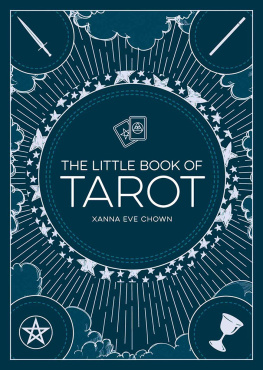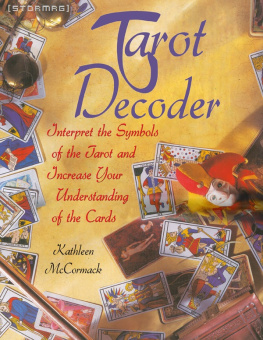M YSTICAL O RIGINS
of the T AROT
From Ancient Roots to Modern Usage
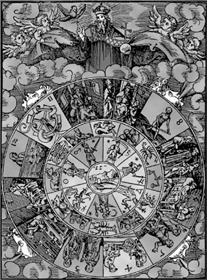
PAUL HUSON
With illustrations by the author

In loving memory of Olga and Carl

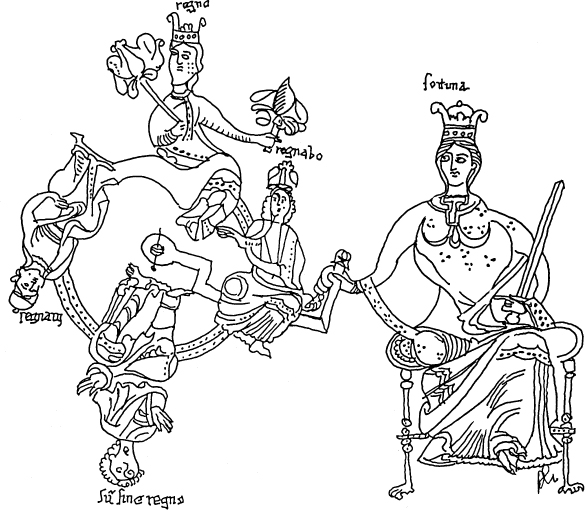
The Wheel of Fortune
The Roman goddess Fortuna was still respected and placated during the Middle Ages as the ruler of human destinies.
ACKNOWLEDGMENTS
T hanks are due to the following for their help in preparing this book: Stuart R. Kaplan for providing me material on the Mamlk cards so long ago; Andrea Pollett for important information about the Mamlk suit signs; Ron Decker for sharing with me his expertise on tarot symbolism and Etteilla; Giordano Berti for his help in trying to locate the elusive tarocchi of Vittoriano Facco; Jess Karlin for his pointers on tarot and magic; Mary K. Greer for a careful reading of an early draft followed by learned and constructive suggestions; the International Playing-Card Society, notably Christopher Rayner, Dr. Michael Cooper, and Barbara Clarke, for their help in locating valuable playing-card research; the staff of the British Library, London, for their diligence in locating material on medieval drama; Susan Jeffers and Mark Shelmerdine for their supportive enthusiasm throughout the long history of this project; Niki Marvin for her love, encouragement, and spiritual fortitude; Mel Raab for coming to my assistance with his timely technical wizardry; Martha Millard for her long-standing faith in the book; Jon Graham for his persistence and tenacity in bringing the book to publication; Vickie Trihy and Bronwyn Becker for their erudite and constructive input to the final manuscript; and last but definitely not least, William Bast, who made everything possible.
CONTENTS

ABOUT THE ILLUSTRATIONS
The Wheel of Fortune, after a ninth-century manuscript in the John Rylands Library, Manchester.
PREFACE
King of Spades and Queen of Clubs, after a fifteenth-century French hand-painted deck.
INTRODUCTION
from left to right: Ace of Cups, Ace of Coins, Ace of Polo Sticks, and Ace of Swords, after fifteenth-century Mamlk cards in the Topkapi Sarayi Museum, Istanbul.
from left to right: Two of Swords, after a fifteenth-century Mamlk card in the Topkapi Sarayi Museum, Istanbul.
Two of Swords, after a Tarot of Marseillepattern deck.
Three of Polo Sticks, after a fifteenth-century Mamlk card in the Topkapi Sarayi Museum, Istanbul.
Three of Batons, after a Tarot of Marseillepattern deck.
Six Cash (Coins) and Six Strings of Coins (Batons), after Chinese money-suited Dongguan Pai cards.
The malik at-tmn, King of the Ten Thousand suit, after a fifteenth-century Mamlk card in the Topkapi Sarayi Museum, Istanbul.
Queen and King of Batons, after the fifteenth-century Visconti-Sforza tarocchi deck painted by Bonifacio Bembo.
Knave and Knight of Batons, after the fifteenth-century Visconti-Sforza tarocchi deck painted by Bonifacio Bembo.
Hector, Caesar, and Alexander, After an illustration of the Nine Worthies from Le chevalier errant, 1394, MS 12559, fol. 1. Bibliothque Nationale, Paris.
King David. After an illustration of the Nine Worthies from Le chevalier errant, 1394, MS 12559, fol. 1. Bibliothque Nationale, Paris.
King Arthur and the Emperor Charlemagne. After an illustration of the Nine Worthies from Le chevalier errant, 1394, M.S. 12559, fol. 1. Bibliothque Nationale, Paris.
Death, the Devil, the Tower, the Star, the Lovers, Temperance, Justice, Fortitude, the Queens of Cups, Swords, and Coins, and the Juggler. After a partial sheet of printed woodcut tarocchi, Florence, fifteenth century. Rosenwald Collection, National Gallery of Art, Washington DC.
Mars, after the fifteenth-century Mantegna engraving.
The Female Pope, the Emperor, the Empress, the Moon, the Star, and the Juggler, after a partial sheet of woodcut tarocchi, probably from Milan, fifteenth century. Cary Collection, Beinecke Library, Yale University.
The Mamlk suit signs and their European derivatives.
CHAPTER
The Great King, Darius I of Persia, after a sixth to fifth century B.C.E. relief from Persepolis.
: Clockwise from the top left, the angels of Prudence, Justice, Temperance, and Fortitude, after Luca della Robbia, the ceiling of the Cardinal of Portugals chapel, San Miniato al Monte, Florence.
: A Persian Magus, after a gold votive plaque in the British Museum, seventh to sixth century B.C.E.
CHAPTER
, top: Limbo and Hell-Mouth, after a sixteenth-century manuscript by Hubert Cailleau, showing the setting for the mystery play at Valenciennes, 1547. The blazing towers of limbo and hell lie at the far right of the stage. Lucifer rises above the tower of hell, mounted on a dragon.
, right: The Devil trump, after a card in the Tarot of Jacques Viville, Paris, 1650.
, left: After an original devils costume for a fifteenth-century mystery play, formerly in the possession of Count Dr. Hans Wilczek at Castle Seebarn, Korneuburg, Austria.
, right: After devils masks for the mystery play at Sterzing, originally in the Ferdinandeum collection, Innsbrck.
: After the Dance of Death, by the sixteenth-century painter Jakob von Wyl. Death comes for the Emperor, the Pope, and the King.
: Dame Fortune, blindfolded and holding her ever-turning wheel, enthroned opposite Dame Wisdom (Prudence), holding her mirror and seated on her throne of virtues. Sixteenth-century French engraving.
: Pope Joan with her child, after a woodcut from the Chronicle ofHartmann Schedel, Nremberg, 1493.
: Engraving by Erhard Schn in Leonhard Reymanns Nativitt Kalender, Nremberg, 1515, showing horoscope house images similar to six tarot trumps: the Wheel of Fortune, the Emperor, the Pope, Death, the Lovers, and the Sun.
CHAPTER
: Thoth, the Egyptian god of wisdom and writing, after the papyrus of Taukherit, twenty-first dynasty, Rijkmuseum van Oudheden, Leiden.
: After images from Eyn Loszbuch ausz der Karten gemacht, an early-sixteenth-century German oracle book involving the use of playing cards.
: After a Wheel of Fortune illustration from Il libro di ventura overa il libro de la sorte, di Lorenzo Spirito, Milan, 1501, an early-sixteenth-century Italian oracle book.
CHAPTER
: Trump 0, the Fool, after a card from the Tarot of Marseille of Nicholas Conver, 1761, Bibliothque Nationale, Paris.
, right: Court Fool in his official costume, after a woodcut, Cosmographie Universelle of Mnster, Basel, 1552.
, bottom: The Fool disports himself with a childs windmill to which is attached a balloon. His right arm and leg bear metal restraints or cuffs, and from the cuff on his arm dangles a broken chain. After an engraved illustration of Bolognese tarocchini, Giuseppe Maria Mitelli, 1664.
: Trump I, the Juggler, after a card from the Tarot of Marseille of Nicholas Conver, 1761, Bibliothque Nationale, Paris.
Next page
